| Image | Common name | Scientific name | Distribution |
|---|
 | White woodpecker | Melanerpes candidus | Suriname, French Guiana, Brazil, Bolivia, Paraguay, Uruguay and Argentina. |
 | Lewis's woodpecker | Melanerpes lewis | western and central United States |
 | Guadeloupe woodpecker | Melanerpes herminieri | Guadeloupe archipelago |
 | Puerto Rican woodpecker | Melanerpes portoricensis | Puerto Rico |
 | Red-headed woodpecker | Melanerpes erythrocephalus | southern Canada and the east-central United States. |
 | Acorn woodpecker | Melanerpes formicivorus | Oregon, California, and the southwestern United States, south through Central America to Colombia. |
 | Yellow-tufted woodpecker | Melanerpes cruentatus | Bolivia, Brazil, Colombia, Ecuador, French Guiana, Guyana, Peru, Suriname, and Venezuela. |
 | Yellow-fronted woodpecker | Melanerpes flavifrons | Brazil, Paraguay and far northeastern Argentina. |
 | Golden-naped woodpecker | Melanerpes chrysauchen | Costa Rica and western Panama |
 | Beautiful woodpecker | Melanerpes pulcher | Colombia. |
 | Black-cheeked woodpecker | Melanerpes pucherani | southeastern Mexico south to western Ecuador. |
 | White-fronted woodpecker | Melanerpes cactorum | Bolivia, Paraguay and Argentina. |
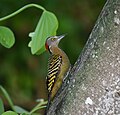 | Hispaniolan woodpecker | Melanerpes striatus | Hispaniola (Haiti and the Dominican Republic) |
 | Jamaican woodpecker | Melanerpes radiolatus | Jamaica. |
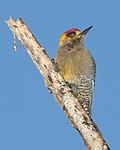 | Golden-cheeked woodpecker | Melanerpes chrysogenys | Mexico |
 | Grey-breasted woodpecker | Melanerpes hypopolius | southwestern Mexico. |
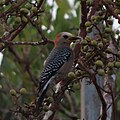 | Yucatan woodpecker | Melanerpes pygmaeus | Belize and Mexico |
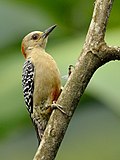 | Red-crowned woodpecker | Melanerpes rubricapillus | Costa Rica, Panama, Colombia, Venezuela, the Guianas and Tobago. |
 | Gila woodpecker | Melanerpes uropygialis | southwestern United States and western Mexico. |
 | Hoffmann's woodpecker | Melanerpes hoffmannii | southern Honduras south to Costa Rica |
 | Golden-fronted woodpecker | Melanerpes aurifrons | Texas and Oklahoma in the United States through Mexico, Belize, Guatemala, El Salvador, Honduras and northern Nicaragua. |
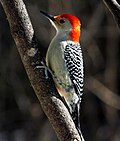 | Red-bellied woodpecker | Melanerpes carolinus | eastern United States |
 | West Indian woodpecker | Melanerpes superciliaris | Bahamas, the Cayman Islands and Cuba. |
|































